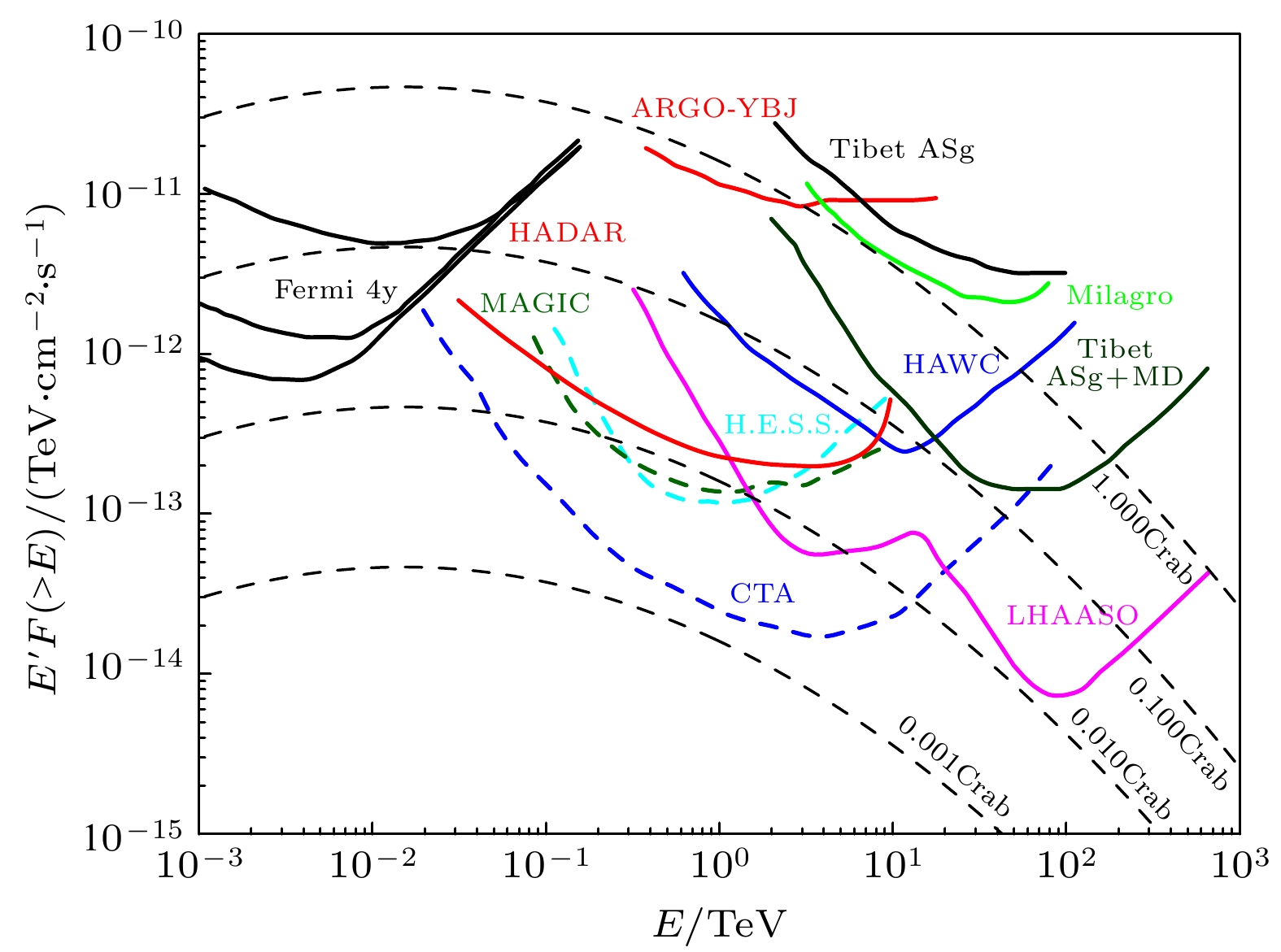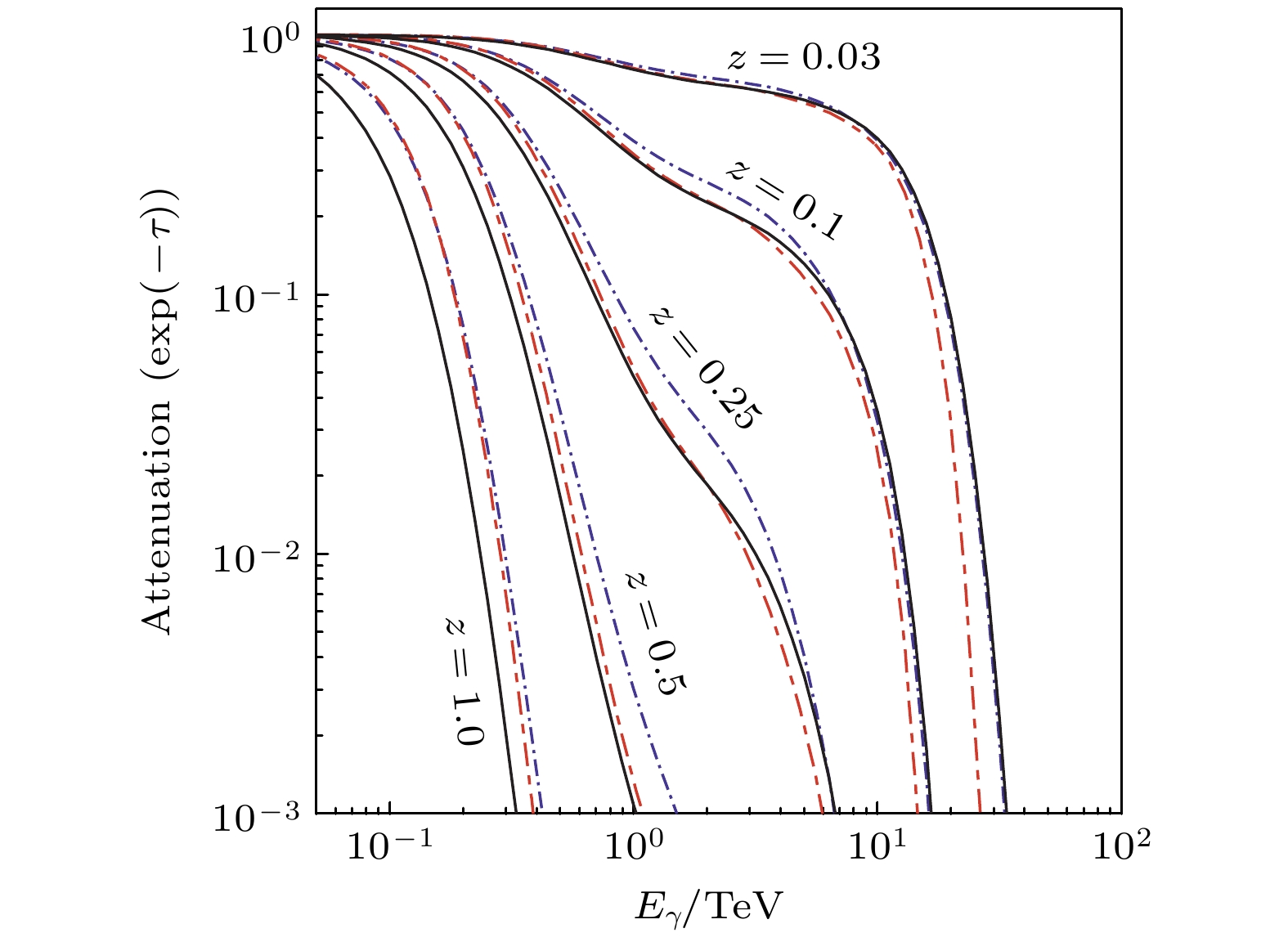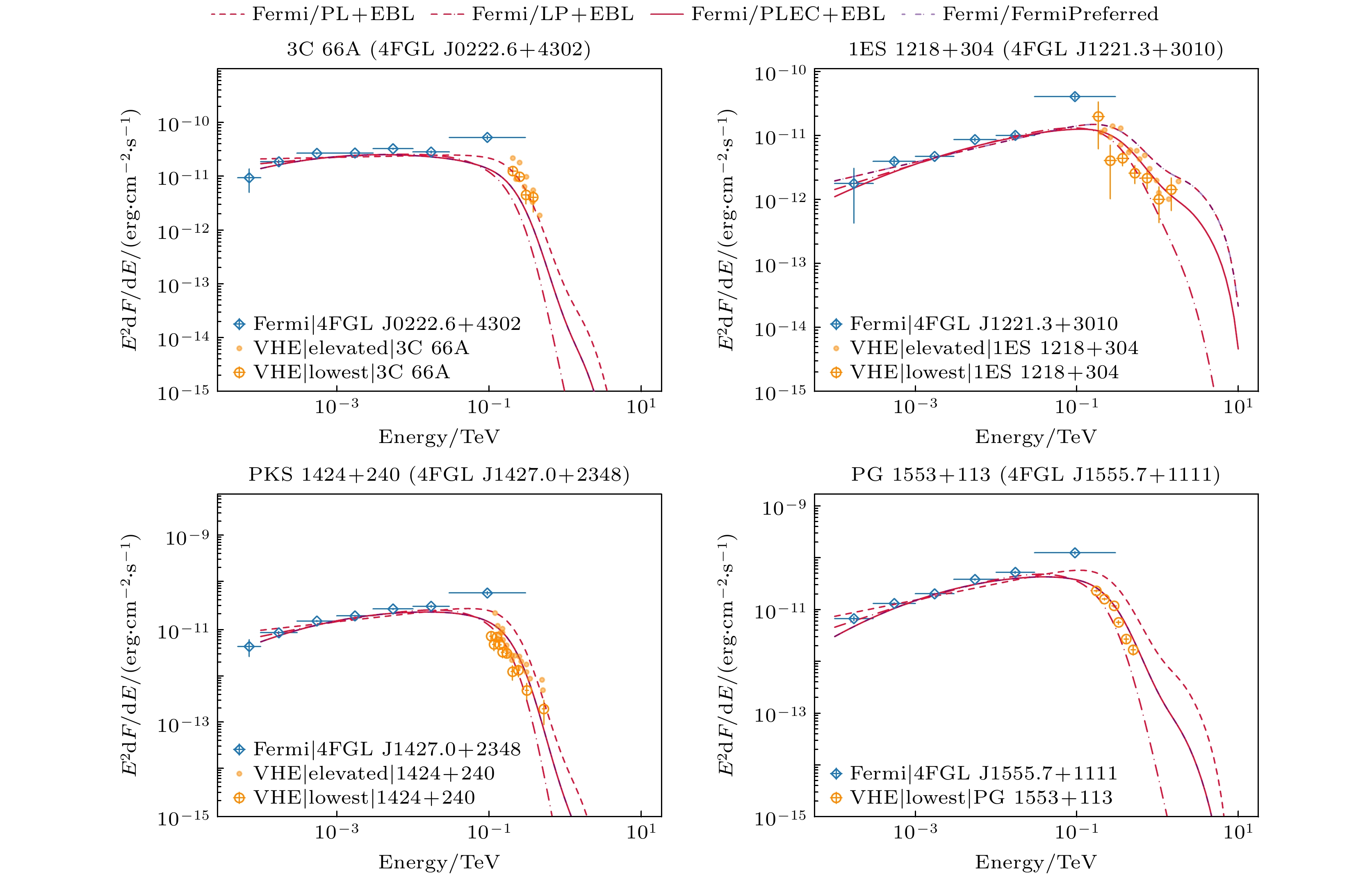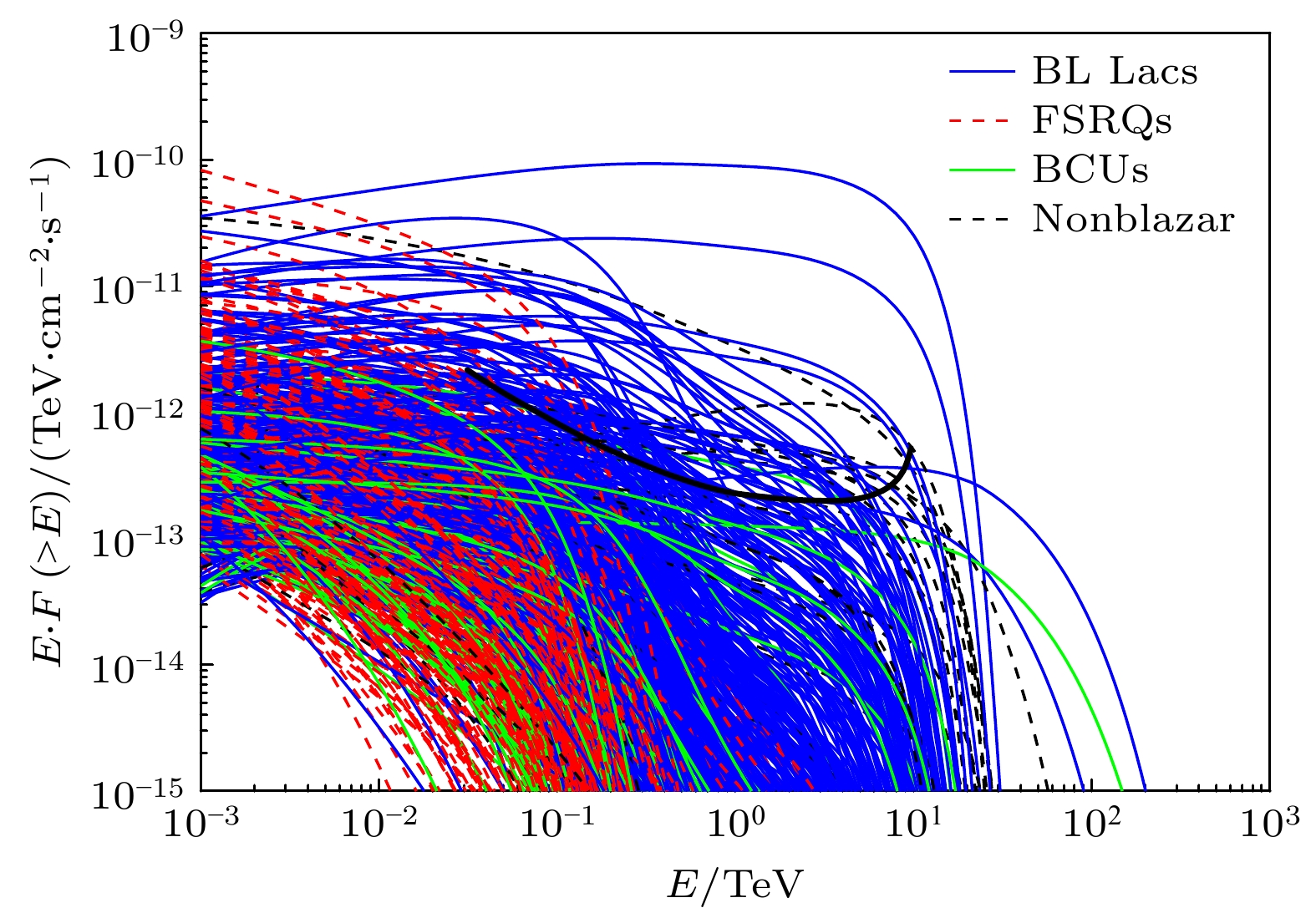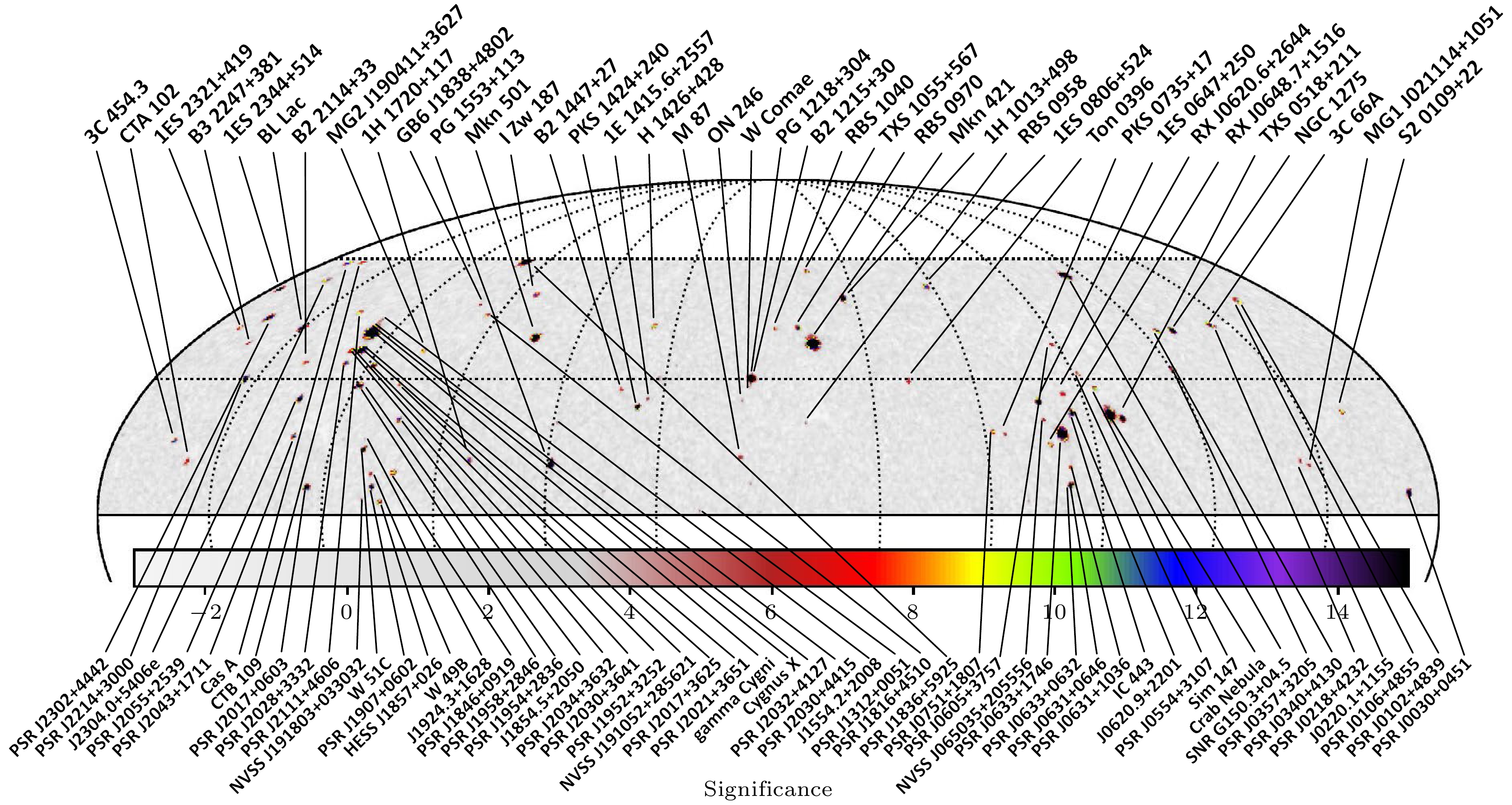-
高海拔天体辐射探测(high altitude detection of astronomical radiation, HADAR)实验是一个新型的采用纯水作为介质的大气切伦科夫望远镜实验阵列, 其采用大口径半球型透镜来收集大气切伦科夫光, 以实现对10 GeV—10 TeV能量段的伽马射线和宇宙线的探测. HADAR具有低阈能、高灵敏度和传统成像大气切伦科夫望远镜所不具备的大视场优势, 可以对天区进行连续扫描观测, 因此将成为全天伽马源的理想观测仪器和爆发源、时变源的理想搜寻探测器. 本文基于Fermi-LAT的最新伽马射线源表, 详细研究了HADAR实验对这些源的观测能力. 对银河系外的源, 将这些源的能谱加入河外背景光吸收效应外推至甚高能段. 通过对这些源的显著性进行模拟研究, 结果显示HADAR运行一年预期有93个伽马射线源以大于5倍的显著性标准偏差被观测到, 其中包括45个银河系内的源, 39个银河系外的源, 3个未知类型的源和6个未关联类型的源.High altitude detection of astronomical radiation (HADAR) is an innovative array of atmospheric Cherenkov telescopes that employs pure water as its medium. By utilizing large-aperture hemispherical lenses, HADAR can capture atmospheric Cherenkov light, enabling the detection of gamma rays and cosmic rays in the energy range of 10 GeV to 10 TeV. Compared to traditional Imaging Atmospheric Cherenkov telescopes, HADAR offers distinct advantages such as a low energy threshold, high sensitivity, and a wide field of view. The telescope mainly consists of a hemispherical lens with a diameter of 5 m acting as a Cherenkov light collector, a cylindrical metal tank with a 4 m radius and 7 m height, and an imaging system at the bottom of the tank. The sky region covered by HADAR is much larger than the current generation of Imaging Atmospheric Cherenkov Telescopes. The field of view of HADAR can reach up to 60 degrees. Its continuous scanning capability allows for comprehensive observations of gamma-ray sources throughout the entire celestial sphere, making it an ideal instrument for studying transient and variable sources. In this study, the observational capabilities of HADAR are thoroughly investigated using the latest 4FGL-DR3 and 4LAC-DR3 gamma-ray source catalogs from Fermi-LAT. For extragalactic sources, the energy spectra in the high energy range have been extrapolated to the very high energy range, taking into account the absorption effect caused by extragalactic background light. By comparing the extrapolated results with existing VHE experimental data, the feasibility of this extrapolation method has been demonstrated. Through simulated analyses of the significance of these sources, it is anticipated that HADAR will detect a total of 93 gamma-ray sources with a significance exceeding 5 standard deviations during one year of operation. These sources comprise 45 galactic sources, 39 extragalactic sources, 3 sources of unknown type, and 6 unassociated sources.
-
Keywords:
- HADAR /
- atmospheric Cherenkov telescope /
- gamma-ray source /
- blazar
[1] Hinton J A 2004 New Astron. Rev. 48 331
 Google Scholar
Google Scholar
[2] Albert J, Aliu E, Anderhub H 2008 Astrophys. J. 674 1037
 Google Scholar
Google Scholar
[3] Holder J, Acciari V, Aliu E 2008 4th International Symposium on High Energy Gamma-Ray Astronomy, Heidelberg, Germany, July 7–11, p657
[4] CTA Consortium 2018 Science with the Cherenkov Telescope Array (Singapore: World Scientific) pp11–26
[5] Ellison D C, Drury L O’C, Meyer J P 1997 Astrophys. J. 487 197
 Google Scholar
Google Scholar
[6] Gaensler B M, Slane P O 2006 Annu. Rev. Astron. Astr. 44 17
 Google Scholar
Google Scholar
[7] Abdalla H, Abramowski A, Aharonian F 2018 Astron. Astrophys. 612 A1
 Google Scholar
Google Scholar
[8] Abeysekara A U, Archer A, Aune T 2018 Astrophys. J. 861 134
 Google Scholar
Google Scholar
[9] Albert A, Alfaro R, Alvarez C 2020 Astrophys. J. 905 76
 Google Scholar
Google Scholar
[10] Antonucci R 1993 Annu. Rev. Astron. Astr. 31 473
 Google Scholar
Google Scholar
[11] Urry C M, Padovani P 1995 Publ. Astron. Soc. Pac. 107 803
 Google Scholar
Google Scholar
[12] Sikora M, Begelman M C, Rees M J 1994 Astrophys. J. 421 153
 Google Scholar
Google Scholar
[13] Aharonian F 2000 New. Astron. 5 377
 Google Scholar
Google Scholar
[14] Mücke A, Protheroe R J, Engel R, Rachen J P, Stanev T 2003 Astropart. Phys. 18 593
 Google Scholar
Google Scholar
[15] Mannheim K, Biermann P L 1989 Astron. Astrophys. 221 211
[16] Mannheim K 1998 Science 279 684
 Google Scholar
Google Scholar
[17] Böttcher M, Reimer A, Sweeney K, Prakash A 2013 Astrophys. J. 768 54
 Google Scholar
Google Scholar
[18] Urry C M 1999 Astropart. Phys. 11 159
 Google Scholar
Google Scholar
[19] Abdo A A, Ackermann M, Agudo I 2010 Astrophys. J. 716 30
 Google Scholar
Google Scholar
[20] Abdo A A, Ackermann M, Ajello M 2010 Astrophys. J. 715 429
 Google Scholar
Google Scholar
[21] Xin G G, Yao Y H, Qian X L 2021 Astrophys. J. 923 112
 Google Scholar
Google Scholar
[22] Qian X L, Sun H Y, Chen T L 2022 Front. Phys.-Beijing 17 64602
 Google Scholar
Google Scholar
[23] Qian X L, Sun H Y, Chen T L 2023 Acta Phys. Sin. 72 049501 [钱祥利, 孙惠英, 陈天禄 2023 物理学报 72 049501
 Google Scholar
Google Scholar
Qian X L, Sun H Y, Chen T L 2023 Acta Phys. Sin.72 049501  Google Scholar
Google Scholar
[24] Ajello M, Atwood W B, Baldini L 2017 Astrophys. J. Suppl. S. 232 18
 Google Scholar
Google Scholar
[25] Aleksić J, Ansoldi S, Antonelli L A 2016 Astropart. Phys. 72 76
 Google Scholar
Google Scholar
[26] Bartoli B, Bernardini P, Bi X J 2013 Astrophys. J. 779 27
 Google Scholar
Google Scholar
[27] Abeysekara A U, Alfaro R, Alvarez C 2013 Astropart. Phys. 50 26
[28] Amenomori M, Bi X J, Chen D 2009 Astrophys. J. 692 61
 Google Scholar
Google Scholar
[29] Ma X H, Bi Y J, Cao Z 2022 Chin. Phys. C 46 030001
 Google Scholar
Google Scholar
[30] Cai H, Zhang Y, Liu C 2017 J. Instrum. 12 09023
[31] Chen T L, Liu C, Gao Q 2019 Nucl. Instrum. Meth. A 927 46
 Google Scholar
Google Scholar
[32] Atwood W B, Abdo A A, Ackermann M 2009 Astrophys. J. 697 1071
 Google Scholar
Google Scholar
[33] Abdollahi S, Acero F, Baldini L 2022 Astrophys. J. Suppl. S. 260 53
 Google Scholar
Google Scholar
[34] Ajello M, Baldini L, Ballet J 2022 Astrophys. J. Suppl. S. 263 24
 Google Scholar
Google Scholar
[35] Abdollahi S, Acero F, Ackermann M 2020 Astrophys. J. Suppl. S. 247 33
 Google Scholar
Google Scholar
[36] Ajello M, Angioni R, Axelsson M 2020 Astrophys. J. 892 105
 Google Scholar
Google Scholar
[37] Gilmore R C, Somerville R S, Primack J R, Domínguez A 2012 Mon. Not. R. Astron. Soc. 422 3189
 Google Scholar
Google Scholar
[38] Domínguez A, Primack J R, Rosario D J 2011 Mon. Not. R. Astron. Soc. 410 2556
 Google Scholar
Google Scholar
[39] Patel S, Maier G, Kaaret P 2021 arXiv: 210806424 [astro-ph.HE
[40] Ghisellini G, Righi C, Costamante L, Tavecchio F 2017 Mon. Not. R. Astron. Soc. 469 255
 Google Scholar
Google Scholar
[41] Abdalla H, Abe H, Acero F 2021 J. Cosmol. Astropart. P. 2021 048
 Google Scholar
Google Scholar
[42] Amenomori M, Ayabe S, Chen D 2005 Astrophys. J. 633 1005
 Google Scholar
Google Scholar
[43] Aliu E, Archambault S, Arlen T 2012 Astrophys. J. 750 94
 Google Scholar
Google Scholar
[44] Abramowski A, Acero F, Aharonian F 2012 Astron. Astrophys. 538 A103
 Google Scholar
Google Scholar
[45] Abramowski A, Acero F, Aharonian F 2013 Mon. Not. R. Astron. Soc. 434 1889
 Google Scholar
Google Scholar
[46] Aleksić J, Antonelli L A, Antoranz P 2011 Astrophys. J. Lett. 730 L8
 Google Scholar
Google Scholar
[47] Aharonian F, Akhperjanian A G, Bazer-Bachi A R 2007 Astron. Astrophys. 470 475
 Google Scholar
Google Scholar
[48] Aharonian F, Akhperjanian A G, de Almeida U B 2007 Astron. Astrophys. 475 L9
 Google Scholar
Google Scholar
[49] Aleksić J, Ansoldi S, Antonelli L A 2014 Science 346 1080
 Google Scholar
Google Scholar
[50] H.E.S.S. Collaboration 2020 Nature 582 356
 Google Scholar
Google Scholar
[51] VERITAS Collaboration, VLBA 43 GHz M87 Monitoring Team, H.E.S.S. Collaboration, MAGIC Collaboration 2009 Science 325 444
 Google Scholar
Google Scholar
[52] Acero F, Aharonian F, Akhperjanian A G 2009 Science 326 1080
 Google Scholar
Google Scholar
[53] Abdalla H, Aharonian F, Benkhali F A 2018 Astron. Astrophys. 617 A73
 Google Scholar
Google Scholar
[54] Acciari V A, Aliu E, Arlen T 2009 Nature 462 770
 Google Scholar
Google Scholar
[55] Abdo A A, Ackermann M, Ajello M 2010 Astrophys. J. Lett. 709 L152
 Google Scholar
Google Scholar
-
图 3 伽马射线衰减因子与能量的关系图, 分别对应红移为0.03, 0.1, 0.25, 0.5和1.0处的源. 实线代表基于威尔金森微波各向异性探测器卫星(WMAP5)数据的模型, 作为对比, 基于固定参数的WMAP5模型(紫色点划线)和Domínguez模型[38] (红色点划线)也分别画出. 可以看出伽马射线的衰减主要集中在甚高能段, 随着红移的增加吸收效应逐渐变强, 且衰减逐渐向低能段发展. 低红移时在1—10 TeV能量区间存在一个较平缓的变化[37]
Fig. 3. Attenuation
${\rm{e}}^{-\tau}$ of gamma-rays versus gamma-ray energy, for sources at z = 0.03, 0.1, 0.25, 0.5 and 1.0. Results are compared for Wilkinson microwave anisotropy probe 5-year (WMAP5, solid) and WMAP5 + fixed (dash-dotted violet) models, as well as the model of Domínguez[38] (dash-dotted red). Increasing distance causes absorption features to increase in magnitude and appear at lower energies. A plateau can be seen between 1–10 TeV at low redshift[37]图 4 外推得到的源3C 66A, 1ES 1218+304, PKS 1424+240和PG 1553+113的宽能量段伽马射线谱能量分布图, 可以看出, 采用内禀谱函数加EBL吸收的谱模型能较好地描述能谱的实验观测数据. 其中低能段为Fermi-LAT 4FGL的实验数据(蓝色菱形), VHE能段为VERITAS的实验数据(黄色圆圈代表低态, 黄色圆点代表不同耀发态的数据). 三种不同的红色虚线分别代表不同的谱函数模型, 实线代表Fermi-LAT采用的谱函数. 纵坐标代表观测的流强, 其中包含了EBL的吸收效应
Fig. 4. Gamma-ray spectral energy distribution for the sources 3C 66A, 1ES 1218+304, PKS 1424+240, and PG 1553+113 obtained over a wide energy range by extrapolation. The resulting data show that the spectral models using the intrinsic spectral function and EBL absorption fit the experimental data well. The Fermi-LAT 4FGL data is represented by blue diamonds in the low-energy band, while in the VHE band the VERITAS data is depicted by yellow circles for the low state and yellow dots for the different flaring states. Three different red dashed lines represent different spectral function models, while the solid line represents the Fermi-LAT preferred function. The y-axis represents the flux, which includes the absorption effect of EBL
图 5 河外源的预期能谱图, 图中蓝色实线为BL Lacs, 红色虚线为FSRQs, 绿色实线为BCUs, 黑色虚线为Nonblazar AGN, 黑色实线为HADAR运行1 a的灵敏度曲线
Fig. 5. Expected energy spectrum for extragalactic sources. The blue solid line represents BL Lacs, the red dashed line represents FSRQs, the green solid line represents BCUs, the black dashed line represents Nonblazar AGN, and the black solid line indicates the sensitivity of HADAR operating for 1 a
图 6 赤道坐标系(J2000 坐标)下HADAR对Fermi-LAT源的观测显著性预期天图, 上面标注为河外源, 下面标注为河内源及未知类型和未关联的源, 显著性显示范围为–3—15
Fig. 6. Expected significance sky map of HADAR observations with respect to Fermi-LAT sources in the equatorial coordinates (J2000 epoch). The map is annotated with extragalactic sources above, and with galactic sources, unknown sources, and unassociated sources below. Significance levels are displayed in the range of –3 to 15
表 1 HADAR及其他IACT和EAS实验的性能对比, 表中列出了各实验的名称、覆盖天区、视场、能量阈值、角分辨、观测点源的灵敏度和参考文献
Table 1. Comparison of the performance of HADAR and other IACT/EAS experiments. For each experiment, the name, spatial coverage, field of view, energy threshold, angular resolution, point-source ssensitivity and reference are given.
Experiment Hemisphere/(N, S) FOV/sr Energy threshold Angular resolution/(°) Sensitivity/Crab Ref. Fermi-LAT 2FHL space 2.7 10 GeV–2 TeV 0.1°(30 GeV) 3%–4% [24] LHAASO-WCDA N 1.5 100 GeV–30 TeV 0.4°(2 TeV) < 10% [29] HAWC N 1.5 100 sGeV–10 sTeV ~0.5° 5%–10% [9] H.E.S.S. S 0.006 30 GeV–100 TeV 0.08° 0.4%–2.0% [7] MAGIC N 0.003 50 GeV–10 TeV ~0.1° ~0.7% [25] CTA N, S 0.0048–0.015 20 GeV–300 TeV 0.07°(1 TeV) 0.2%–0.4% [4] HADAR N 0.84 10 GeV–10 TeV 0.4°(100 GeV) 1.3%–2.4% [22] 表 2 HADAR视场内4个AGN源的性质参数, 谱的模型参数从4LAC/4FGL导出. 表中从左到右分别为: 4FGL源名称、源对应体、AGN类型、SED分类、红移、模型, 该谱模型下的能量参考值、对应在能量
$ E_0 $ 处的微分流强、谱指数Γ和曲率参数βTable 2. Property parameters for four AGN sources, where the spectral model parameters are based on 4LAC or 4FGL. Columns from left to right are as follows: 4FGL source name, counterpart, type, class, redshift, model,
$ E_0 $ , differential flux at$ E_0 $ with the fit model, spectral index Γ, curvature parameter β4FGL Name Counterpart Type Class Redshift Model E0/GeV F0 /(TeV–1·cm–2·s–1) Γ β J0222.6+4301 3C 66A BLL ISP 0.444 LP 1.197 1.03 × 10–5 1.89 0.04 J1221.3+3010 1ES 1218+304 BLL EHSP 0.184 PL 4.501 1.83 × 10–7 1.71 — J1427.0+2348 PKS 1424+240 BLL HSP 0.604 LP 1.205 7.03 × 10–6 1.71 0.06 J1555.7+1111 PG 1553+113 BLL HSP 0.360 LP 1.802 3.84 × 10–6 1.54 0.07 表 3 HADAR预期观测到的Fermi-LAT源的种类和数目
Table 3. Types and numbers of Fermi-LAT sources that HADAR is expected to detect
4FGL-DR3 source classes Number of sources in 4FGL-DR3 Number of sources in HADAR FOV Expected to be observed by HADAR in 1 a Expected to be observed by HADAR in 5 a Young / Millisecond pulsars 292 106 34 52 PWNe, SNR 63 22 10 13 SNR / PWNe 114 26 0 1 Globular cluster 35 5 0 0 Star-forming region 5 2 1 1 High-mass Binary, Low-mass Binary, Binary, Nova 30 6 0 0 BL Lacs 1458 492 34 66 FSRQs 792 376 2 5 Blazar candidate of uncertain type 1493 88 0 2 Nonblazar AGN (RDG, AGN, SSRQ, CSS, NLSY1, SEY) 71 36 3 8 Starburst galaxy 8 3 0 0 Normal galaxy 6 3 0 0 Unkown 134 48 3 7 Unassociated 2157 592 6 25 Total 6658 1805 93 180 表 4 HADAR视场内Fermi-LAT河外源的能谱参数及观测信息, 谱的参数从4LAC-DR3导出. 表中从左到右分别为: 4FGL源名称, 源对应体, 赤经, 赤纬, SED分类, 红移, 拟合模型, 该谱模型下的能量参考值, 对应在能量
$ E_0 $ 处的微分流强, 谱指数Γ, 曲率参数β, 有效观测时间, 观测显著性Table 4. Property parameters for extragalactic sources in HADAR FOV, where the spectral model parameters are derived from 4LAC-DR3. Columns from left to right are as follows: 4FGL source name, counterpart, right ascension, declination, class, redshift, model,
$ E_0 $ , differential flux at$ E_0 $ with the fit model, spectral index Γ, curvature parameter β, live time and significance4FGL name Counterpart R.A. Dec. Type Redshift Model E0/GeV F0/(TeV–1·cm–2·s–1) Γ β Time/h S/σ J0112.1+2245 S2 0109+22 18.03 22.75 BLL 0.265 LP 0.769 1.46 × 10–5 1.99 0.060 277.8 9.05 J0211.2+1051 MG1J021114+1051 32.81 10.86 BLL 0.200 LP 0.922 7.51 × 10–6 2.02 0.042 196.3 6.47 J0222.6+4302 3C 66A 35.67 43.04 BLL 0.444 LP 1.246 8.40 × 10–6 1.89 0.046 264.2 17.9 J0319.8+4130 NGC 1275 49.96 41.51 RDG 0.018 LP 0.918 4.36 × 10–5 2.05 0.069 271.9 54.6 J0521.7+2112 TXS 0518+211 80.44 21.21 bll 0.108 LP 1.541 4.64 × 10–6 1.86 0.045 271.0 50.2 J0620.7+2643 RX J0620.6+2644 95.18 26.73 bll 0.134 PL 17.415 1.22 × 10–9 1.55 — 290.3 5.1 J0648.7+1516 RX J0648.7+1516 102.19 15.28 bll 0.179 LP 3.248 1.22 × 10–7 1.60 0.056 234.3 10.9 J0650.7+2503 1ES 0647+250 102.7 25.05 bll 0.203 LP 2.067 8.44 × 10–7 1.65 0.041 286.0 32.9 J0738.1+1742 PKS 0735+17 114.54 17.71 bll 0.424 LP 1.623 2.25 × 10–6 1.97 0.067 251.3 5.2 J0809.8+5218 1ES 0806+524 122.46 52.31 BLL 0.138 LP 1.342 1.91 × 10–6 1.83 0.023 193.9 15.1 J0915.9+2933 Ton 0396 138.99 29.55 bll 0.190 LP 1.390 9.28 × 10–7 1.74 0.081 294.7 7.4 J1015.0+4926 1H 1013+498 153.77 49.43 bll 0.212 LP 1.044 6.00 × 10–6 1.75 0.044 220.0 27.9 J1058.6+5627 TXS 1055+567 164.67 56.46 BLL 0.143 LP 1.102 2.38 × 10–6 1.86 0.050 149.4 6.1 J1104.4+3812 Mkn 421 166.12 38.21 BLL 0.030 PLEC 1.258 1.79 × 10–5 1.74 — 284.9 519.6 J1117.0+2013 RBS 0958 169.27 20.23 bll 0.139 PL 1.964 3.12 × 10–7 1.95 — 266.1 5.0 J1120.8+4212 RBS 0970 170.20 42.20 bll 0.124 LP 2.416 2.11 × 10–7 1.55 0.046 268.6 23.9 J1150.6+4154 RBS 1040 177.66 41.91 bll 0.320 LP 1.949 4.71 × 10–7 1.55 0.135 270.0 7.2 J1217.9+3007 B2 1215+30 184.48 30.12 BLL 0.130 LP 1.248 5.77 × 10–6 1.87 0.043 295.1 37.7 J1221.3+3010 PG 1218+304 185.34 30.17 bll 0.184 LP 2.590 5.27 × 10–7 1.65 0.029 295.2 37.4 J1221.5+2814 W Comae 185.38 28.24 bll 0.102 LP 0.781 6.00 × 10–6 2.11 0.024 293.1 5.5 J1230.2+2517 ON 246 187.56 25.30 bll 0.135 LP 0.800 6.66 × 10–6 2.02 0.056 286.7 5.8 J1230.8+1223 M 87 187.71 12.39 rdg 0.004 LP 1.124 1.30 × 10–6 2.00 0.036 210.5 5.3 J1417.9+2543 1E 1415.6+2557 214.49 25.72 bll 0.237 LP 8.155 6.13 × 10–9 1.28 0.138 287.9 5.1 J1427.0+2348 PKS 1424+240 216.76 23.80 BLL 0.604 LP 1.254 5.70 × 10–6 1.71 0.057 281.8 21.7 J1428.5+4240 H 1426+428 217.13 42.68 bll 0.129 PL 5.135 2.69 × 10–8 1.65 — 266.1 10.3 J1449.5+2746 B2 1447+27 222.40 27.77 rdg 0.031 PL 14.614 5.37 × 10–10 1.46 — 292.4 6.8 J1555.7+1111 PG 1553+113 238.93 11.19 BLL 0.360 LP 3.802 1.16 × 10–6 1.57 0.095 199.5 56.4 J1653.8+3945 Mkn 501 253.47 39.76 BLL 0.033 LP 1.508 3.78 × 10–6 1.75 0.018 279.5 125.1 J1725.0+1152 1H 1720+117 261.27 11.87 bll 0.180 LP 2.216 7.55 × 10–7 1.76 0.056 205.9 14.5 J1728.3+5013 I Zw 187 262.08 50.23 bll 0.055 PL 2.983 1.82 × 10–7 1.79 — 213.2 21.1 J1838.8+4802 GB6J1838+4802 279.71 48.04 bll 0.300 LP 1.631 8.39 × 10–7 1.78 0.040 231.3 6.7 J1904.1+3627 MG2J190411+3627 286.03 36.45 bll 0.078 PL 5.074 2.01 × 10–8 1.80 — 289.7 5.8 J2116.2+3339 B2 2114+33 319.06 33.66 bll 0.350 LP 1.653 1.10 × 10–6 1.75 0.095 294.4 7.1 J2202.7+4216 BL Lac 330.69 42.28 BLL 0.069 LP 0.871 4.07 × 10–5 2.12 0.059 268.2 27.4 J2232.6+1143 CTA 102 338.15 11.73 FSRQ 1.037 PLEC 1.082 4.34 × 10–5 2.27 — 204.5 5.9 J2250.0+3825 B3 2247+381 342.51 38.42 bll 0.119 PL 5.338 2.55 × 10–8 1.74 — 284.2 7.9 J2253.9+1609 3C 454.3 343.50 16.15 FSRQ 0.859 PLEC 0.892 1.32 × 10–4 2.38 — 240.7 10.9 J2323.8+4210 1ES 2321+419 350.97 42.18 bll 0.059 LP 1.857 5.31 × 10–7 1.80 0.068 268.7 11.0 J2347.0+5141 1ES 2344+514 356.77 51.70 bll 0.044 LP 1.911 7.15 × 10–7 1.74 0.039 199.8 29.2 表 5 HADAR视场内Fermi-LAT河内源的能谱参数及观测信息, 谱的参数从4FGL-DR3导出. 表中从左到右分别为: 4FGL源名称, 源对应体, 赤经, 赤纬, SED分类, 拟合模型, 该谱模型下的能量参考值, 对应在能量
$ E_0 $ 处的微分流强, 谱指数Γ, 曲率参数β, 有效观测时间, 观测显著性Table 5. Property parameters for galactic sources in HADAR FOV, where the spectral model parameters are derived from 4FGL-DR3. Columns from left to right are as follows: 4FGL source name, counterpart, right ascension, declination, class, model,
$ E_0 $ , differential flux at$ E_0 $ with the fit model, spectral index Γ, curvature parameter β, live time and significance4FGL Name Counterpart R.A. Dec. Type Model $ E_0 $/GeV F0/(TeV–1·cm–2·s–1) Γ β Time/h S/σ J0030.4+0451 PSR J0030+0451 7.61 4.86 MSP PLEC 1.360 7.36 × 10–6 2.08 — 130.1 40.6 J0102.8+4839 PSR J0102+4839 15.71 48.66 MSP PLEC 1.378 1.42 × 10–6 2.18 — 226.4 6.0 J0106.4+4855 PSR J0106+4855 16.61 48.93 PSR PLEC 1.578 1.66 × 10–6 2.11 — 224.2 14.2 J0218.1+4232 PSR J0218+4232 34.53 42.55 MSP PLEC 0.820 1.20 × 10–5 2.35 — 266.8 6.2 J0220.1+1155 — 35.04 11.92 — PL 16.622 3.98 × 10–10 1.57 — 206.2 5.6 J0340.3+4130 PSR J0340+4130 55.10 41.51 MSP PLEC 1.659 1.38 × 10–6 2.03 — 271.9 24.6 J0357.8+3204 PSR J0357+3205 59.46 32.08 PSR PLEC 1.104 1.26 × 10–5 2.30 — 295.5 19.3 J0425.6+5522e SNR G150.3+04.5 66.42 55.37 SNR LP 7.240 1.19 × 10–7 1.64 0.047 161.8 123.6 J0534.5+2201i Crab Nebula 83.63 22.02 PWN LP 10.000 5.50 × 10–7 1.75 0.080 274.7 639.6 J0540.3+2756e Sim 147 85.10 27.94 SNR LP 1.192 5.50 × 10–6 2.07 0.081 292.7 11.1 J0554.1+3107 PSR J0554+3107 88.55 31.12 PSR PLEC 1.066 4.06 × 10–6 2.34 — 295.5 5.1 J0605.1+3757 PSR J0605+3757 91.28 37.96 MSP PLEC 1.507 7.88 × 10–7 2.18 — 285.7 5.3 J0617.2+2234e IC 443 94.31 22.58 SNR LP 4.551 2.58 × 10–6 2.28 0.123 277.1 37.6 J0620.9+2201 — 95.23 22.02 — PL 20.913 6.45 × 10–10 1.61 — 274.7 5.7 J0631.5+1036 PSR J0631+1036 97.88 10.60 PSR PLEC 1.540 2.52 × 10–6 2.20 — 193.8 11.1 J0631.8+0645 PSR J0631+0646 97.96 6.76 PSR PLEC 2.258 7.60 × 10–7 2.22 — 152.9 5.9 J0633.7+0632 PSR J0633+0632 98.44 6.54 PSR PLEC 1.527 8.13 × 10–6 2.22 — 150.4 26.3 J0633.9+1746 PSR J0633+1746 98.48 17.77 PSR PLEC 1.670 3.19 × 10–4 2.10 — 251.7 575.7 J0650.6+2055 NVSS J065035+205556 102.66 20.93 unk LP 3.643 4.42 × 10–8 1.63 0.096 269.6 9.5 J0751.2+1808 PSR J0751+1807 117.80 18.14 MSP PLEC 1.643 9.45 × 10–7 2.06 — 254.1 13.1 J1312.7+0050 PSR J1312+0051 198.19 0.84 MSP PLEC 1.301 2.01 × 10–6 2.15 — 76.3 5.7 J1554.2+2008 — 238.55 20.15 — PL 4.619 1.14 × 10–8 1.82 — 265.6 5.0 J1816.5+4510 PSR J1816+4510 274.15 45.17 MSP PLEC 1.171 1.48 × 10–6 2.14 — 251.6 6.1 J1836.2+5925 PSR J1836+5925 279.06 59.43 PSR PLEC 1.428 6.64 × 10–5 2.07 — 112.6 388.8 J1846.3+0919 PSR J1846+0919 281.60 9.33 PSR PLEC 1.458 3.78 × 10–6 2.19 — 181.0 14.9 J1854.5+2050 — 283.64 20.84 — PL 103.233 2.68 × 10–11 1.01 — 269.2 34.8 J1857.7+0246e HESS J1857+026 284.45 2.77 PWN PL 6.063 2.25 × 10–7 2.13 — 103.1 19.5 J1907.9+0602 PSR J1907+0602 286.98 6.04 PSR PLEC 1.898 1.39 × 10–5 2.37 — 144.4 31.3 J1910.8+2856 NVSS J191052+285621 287.72 28.94 unk PL 7.243 6.08 × 10–9 1.80 — 294.1 7.1 J1911.0+0905 W 49B 287.76 9.09 snr LP 4.552 7.74 × 10–7 2.28 0.112 178.6 8.5 J1918.0+0331 NVSS J191803+033032 289.51 3.52 unk PL 12.647 2.39 × 10–9 1.72 — 113.0 6.2 J1923.2+1408e W 51C 290.82 14.14 SNR LP 2.768 5.08 × 10–6 2.21 0.109 225.4 25.9 J1924.3+1628 — 291.10 16.48 — PL 22.893 7.99 × 10–10 1.76 — 243.1 7.7 J1952.9+3252 PSR J1952+3252 298.25 32.88 PSR PLEC 1.618 9.92 × 10–6 2.29 — 295.1 39.3 J1954.3+2836 PSR J1954+2836 298.59 28.60 PSR PLEC 1.519 8.08 × 10–6 2.32 — 293.7 23.1 J1958.7+2846 PSR J1958+2846 299.68 28.77 PSR PLEC 1.356 1.13 × 10–5 2.35 — 293.9 21.1 J2017.4+0602 PSR J2017+0603 304.35 6.05 MSP PLEC 1.800 2.20 × 10–6 1.98 — 144.6 43.2 J2017.9+3625 PSR J2017+3625 304.49 36.43 PSR PLEC 1.467 6.99 × 10–6 2.53 — 289.8 5.7 J2021.0+4031e gamma Cygni 305.27 40.52 SNR LP 7.758 2.07 × 10–7 1.88 0.060 276.4 95.9 J2021.1+3651 PSR J2021+3651 305.28 36.86 PSR PLEC 1.842 2.62 × 10–5 2.32 — 288.8 114.0 J2028.3+3331 PSR J2028+3332 307.08 33.53 PSR PLEC 1.467 6.57 × 10–6 2.32 — 294.6 17.5 J2028.6+4110e Cygnus X 307.17 41.17 SFR LP 2.036 2.90 × 10–5 2.04 0.033 273.5 368.3 J2030.0+3641 PSR J2030+3641 307.51 36.69 PSR PLEC 1.650 3.92 × 10–6 2.33 — 289.2 12.6 J2030.9+4416 PSR J2030+4415 307.73 44.27 PSR PLEC 1.284 6.77 × 10–6 2.47 — 257.2 5.4 J2032.2+4127 PSR J2032+4127 308.06 41.46 PSR PLEC 2.918 3.31 × 10–6 2.26 — 272.2 47.2 J2035.0+3632 PSR J2034+3632 308.76 36.54 MSP PLEC 2.456 5.99 × 10–7 2.17 — 289.5 11.3 J2043.3+1711 PSR J2043+1711 310.84 17.19 MSP PLEC 1.222 3.47 × 10–6 2.10 — 247.9 20.9 J2055.8+2540 PSR J2055+2539 313.96 25.67 PSR PLEC 1.279 8.39 × 10–6 2.18 — 287.7 26.6 J2111.4+4606 PSR J2111+4606 317.86 46.10 PSR PLEC 1.305 4.84 × 10–6 2.26 — 245.4 11.9 J2214.6+3000 PSR J2214+3000 333.67 30.01 MSP PLEC 1.090 5.97 × 10–6 2.06 — 295.1 28.8 J2301.9+5855e CTB 109 345.49 58.92 SNR LP 3.461 1.57 × 10–7 1.91 0.054 119.2 6.8 J2302.7+4443 PSR J2302+4442 345.69 44.72 MSP PLEC 2.049 2.04 × 10–6 2.02 — 254.5 55.8 J2304.0+5406e — 346.01 54.11 — LP 14.034 1.58 × 10–8 1.76 0.127 175.6 18.0 J2323.4+5849 Cas A 350.86 58.82 snr LP 2.232 1.38 × 10–6 1.87 0.076 120.5 20.9 -
[1] Hinton J A 2004 New Astron. Rev. 48 331
 Google Scholar
Google Scholar
[2] Albert J, Aliu E, Anderhub H 2008 Astrophys. J. 674 1037
 Google Scholar
Google Scholar
[3] Holder J, Acciari V, Aliu E 2008 4th International Symposium on High Energy Gamma-Ray Astronomy, Heidelberg, Germany, July 7–11, p657
[4] CTA Consortium 2018 Science with the Cherenkov Telescope Array (Singapore: World Scientific) pp11–26
[5] Ellison D C, Drury L O’C, Meyer J P 1997 Astrophys. J. 487 197
 Google Scholar
Google Scholar
[6] Gaensler B M, Slane P O 2006 Annu. Rev. Astron. Astr. 44 17
 Google Scholar
Google Scholar
[7] Abdalla H, Abramowski A, Aharonian F 2018 Astron. Astrophys. 612 A1
 Google Scholar
Google Scholar
[8] Abeysekara A U, Archer A, Aune T 2018 Astrophys. J. 861 134
 Google Scholar
Google Scholar
[9] Albert A, Alfaro R, Alvarez C 2020 Astrophys. J. 905 76
 Google Scholar
Google Scholar
[10] Antonucci R 1993 Annu. Rev. Astron. Astr. 31 473
 Google Scholar
Google Scholar
[11] Urry C M, Padovani P 1995 Publ. Astron. Soc. Pac. 107 803
 Google Scholar
Google Scholar
[12] Sikora M, Begelman M C, Rees M J 1994 Astrophys. J. 421 153
 Google Scholar
Google Scholar
[13] Aharonian F 2000 New. Astron. 5 377
 Google Scholar
Google Scholar
[14] Mücke A, Protheroe R J, Engel R, Rachen J P, Stanev T 2003 Astropart. Phys. 18 593
 Google Scholar
Google Scholar
[15] Mannheim K, Biermann P L 1989 Astron. Astrophys. 221 211
[16] Mannheim K 1998 Science 279 684
 Google Scholar
Google Scholar
[17] Böttcher M, Reimer A, Sweeney K, Prakash A 2013 Astrophys. J. 768 54
 Google Scholar
Google Scholar
[18] Urry C M 1999 Astropart. Phys. 11 159
 Google Scholar
Google Scholar
[19] Abdo A A, Ackermann M, Agudo I 2010 Astrophys. J. 716 30
 Google Scholar
Google Scholar
[20] Abdo A A, Ackermann M, Ajello M 2010 Astrophys. J. 715 429
 Google Scholar
Google Scholar
[21] Xin G G, Yao Y H, Qian X L 2021 Astrophys. J. 923 112
 Google Scholar
Google Scholar
[22] Qian X L, Sun H Y, Chen T L 2022 Front. Phys.-Beijing 17 64602
 Google Scholar
Google Scholar
[23] Qian X L, Sun H Y, Chen T L 2023 Acta Phys. Sin. 72 049501 [钱祥利, 孙惠英, 陈天禄 2023 物理学报 72 049501
 Google Scholar
Google Scholar
Qian X L, Sun H Y, Chen T L 2023 Acta Phys. Sin.72 049501  Google Scholar
Google Scholar
[24] Ajello M, Atwood W B, Baldini L 2017 Astrophys. J. Suppl. S. 232 18
 Google Scholar
Google Scholar
[25] Aleksić J, Ansoldi S, Antonelli L A 2016 Astropart. Phys. 72 76
 Google Scholar
Google Scholar
[26] Bartoli B, Bernardini P, Bi X J 2013 Astrophys. J. 779 27
 Google Scholar
Google Scholar
[27] Abeysekara A U, Alfaro R, Alvarez C 2013 Astropart. Phys. 50 26
[28] Amenomori M, Bi X J, Chen D 2009 Astrophys. J. 692 61
 Google Scholar
Google Scholar
[29] Ma X H, Bi Y J, Cao Z 2022 Chin. Phys. C 46 030001
 Google Scholar
Google Scholar
[30] Cai H, Zhang Y, Liu C 2017 J. Instrum. 12 09023
[31] Chen T L, Liu C, Gao Q 2019 Nucl. Instrum. Meth. A 927 46
 Google Scholar
Google Scholar
[32] Atwood W B, Abdo A A, Ackermann M 2009 Astrophys. J. 697 1071
 Google Scholar
Google Scholar
[33] Abdollahi S, Acero F, Baldini L 2022 Astrophys. J. Suppl. S. 260 53
 Google Scholar
Google Scholar
[34] Ajello M, Baldini L, Ballet J 2022 Astrophys. J. Suppl. S. 263 24
 Google Scholar
Google Scholar
[35] Abdollahi S, Acero F, Ackermann M 2020 Astrophys. J. Suppl. S. 247 33
 Google Scholar
Google Scholar
[36] Ajello M, Angioni R, Axelsson M 2020 Astrophys. J. 892 105
 Google Scholar
Google Scholar
[37] Gilmore R C, Somerville R S, Primack J R, Domínguez A 2012 Mon. Not. R. Astron. Soc. 422 3189
 Google Scholar
Google Scholar
[38] Domínguez A, Primack J R, Rosario D J 2011 Mon. Not. R. Astron. Soc. 410 2556
 Google Scholar
Google Scholar
[39] Patel S, Maier G, Kaaret P 2021 arXiv: 210806424 [astro-ph.HE
[40] Ghisellini G, Righi C, Costamante L, Tavecchio F 2017 Mon. Not. R. Astron. Soc. 469 255
 Google Scholar
Google Scholar
[41] Abdalla H, Abe H, Acero F 2021 J. Cosmol. Astropart. P. 2021 048
 Google Scholar
Google Scholar
[42] Amenomori M, Ayabe S, Chen D 2005 Astrophys. J. 633 1005
 Google Scholar
Google Scholar
[43] Aliu E, Archambault S, Arlen T 2012 Astrophys. J. 750 94
 Google Scholar
Google Scholar
[44] Abramowski A, Acero F, Aharonian F 2012 Astron. Astrophys. 538 A103
 Google Scholar
Google Scholar
[45] Abramowski A, Acero F, Aharonian F 2013 Mon. Not. R. Astron. Soc. 434 1889
 Google Scholar
Google Scholar
[46] Aleksić J, Antonelli L A, Antoranz P 2011 Astrophys. J. Lett. 730 L8
 Google Scholar
Google Scholar
[47] Aharonian F, Akhperjanian A G, Bazer-Bachi A R 2007 Astron. Astrophys. 470 475
 Google Scholar
Google Scholar
[48] Aharonian F, Akhperjanian A G, de Almeida U B 2007 Astron. Astrophys. 475 L9
 Google Scholar
Google Scholar
[49] Aleksić J, Ansoldi S, Antonelli L A 2014 Science 346 1080
 Google Scholar
Google Scholar
[50] H.E.S.S. Collaboration 2020 Nature 582 356
 Google Scholar
Google Scholar
[51] VERITAS Collaboration, VLBA 43 GHz M87 Monitoring Team, H.E.S.S. Collaboration, MAGIC Collaboration 2009 Science 325 444
 Google Scholar
Google Scholar
[52] Acero F, Aharonian F, Akhperjanian A G 2009 Science 326 1080
 Google Scholar
Google Scholar
[53] Abdalla H, Aharonian F, Benkhali F A 2018 Astron. Astrophys. 617 A73
 Google Scholar
Google Scholar
[54] Acciari V A, Aliu E, Arlen T 2009 Nature 462 770
 Google Scholar
Google Scholar
[55] Abdo A A, Ackermann M, Ajello M 2010 Astrophys. J. Lett. 709 L152
 Google Scholar
Google Scholar
计量
- 文章访问数: 6903
- PDF下载量: 77
- 被引次数: 0













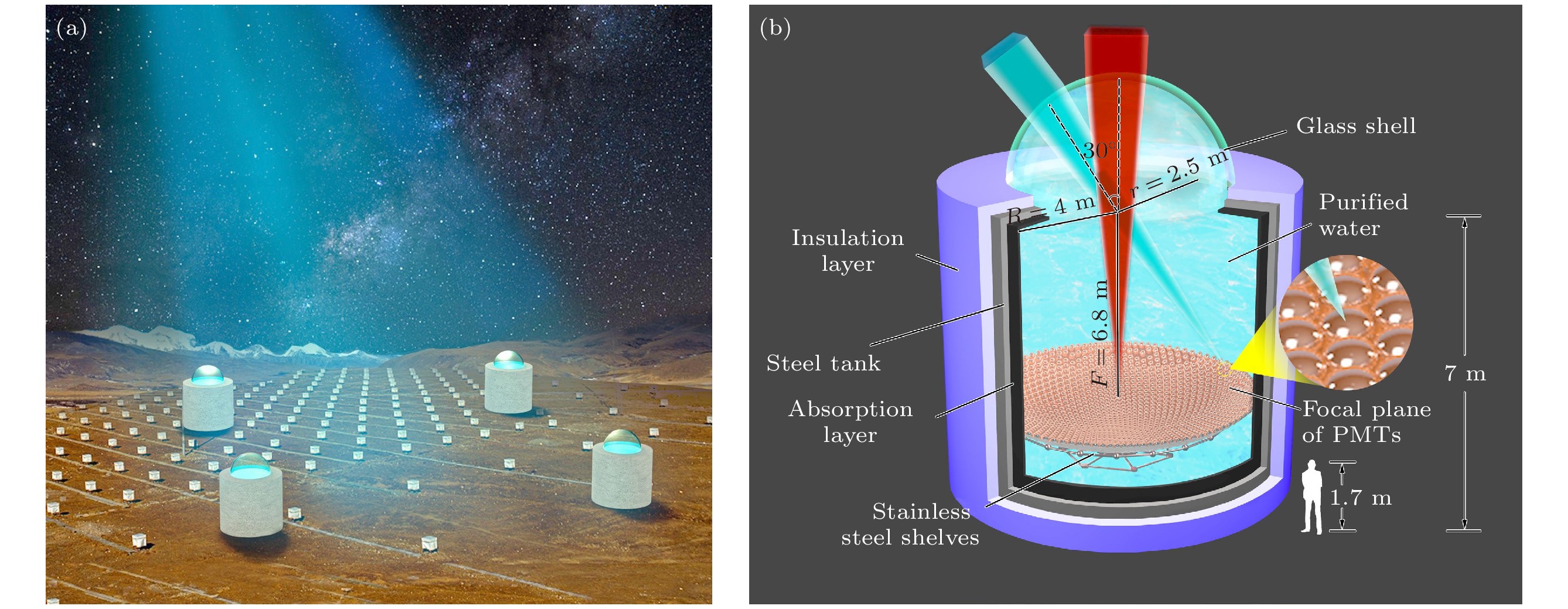
 下载:
下载:
